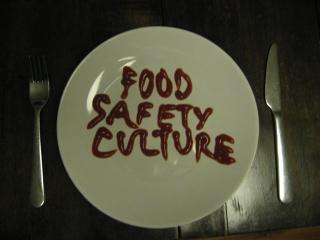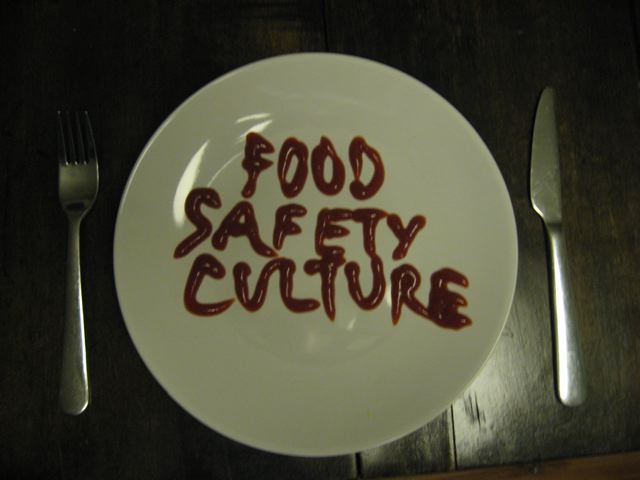
Culture encompasses the shared values, mores, customary practices, inherited traditions, and prevailing habits of communities.
There’s lots of other definitions, but Amy and I spent some time figuring this one out so that’s what we’re going with. (That’s Amy, right, talking about language, culture, memory and  Pied-Noirs, the former French inhabitants of Algeria, at her undergraduate alma mater, Truman University in Kirksville, Missouri, where she was feted Monday night.)
Pied-Noirs, the former French inhabitants of Algeria, at her undergraduate alma mater, Truman University in Kirksville, Missouri, where she was feted Monday night.)
Frank Yiannas, the vice-president of food safety at Wal-Mart wrote in his aptly named 2009 book, Food Safety Culture: Creating a Behavior-based Food Safety Management System, that an organization’s food safety systems need to be an integral part of its culture, and that culture is patterned ways of thought and behaviors that characterize a social group which can be learned through socialization processes and persist through time.
Yiannas also writes:
• The goal of the food safety professional should be to create a food safety
culture – not a food safety program.
• An organization’s culture will influence how individuals within the group
think about food safety, their attitudes toward food safety, their willingness
to openly discuss concerns and share differing opinions, and, in general, the
emphasis that they place on food safety.
• When it comes to creating, strengthening, or sustaining a food safety culture
within an organization, there is one group of individuals who really own it –
they’re the leaders.
• Having a strong food safety culture is a choice. The leaders of an organization
should proactively choose to have a strong food safety culture because
it’s the right thing to do, as opposed to reacting to a significant issue or
outbreak.
• Creating or strengthening a food safety culture will require the intentional
commitment and hard work by leaders at all levels of the organization,
starting at the top.
 • Although no two great food safety cultures will be identical, they are likely to
• Although no two great food safety cultures will be identical, they are likely to
have many similar attributes.
• Identifying food safety best practices can be useful, but one major drawback
to creating such a list is that it doesn’t really demonstrate how these activities
are linked together or interrelated. It misses the big picture – the system.
• To create a food safety culture, you need to have a systems-based approach to
food safety.
Chris Griffith, formerly of the University of Wales in Cardiff, and colleagues, have just published three papers in the British Food Journal with their take on food safety culture.
Griffith proposes that food safety culture is,
The aggregation of the prevailing, relatively constant, learned, shared attitudes, values and beliefs contributing to the hygiene behaviours used within a particular food handling environment.
Griffith also writes there are many attributes from organizational safety culture that can be applied to food safety culture, including:
• it describes beliefs shared by members in an organization;
• it requires a contribution from people at all levels;
• it has an impact on work performance/behaviour, practices or behavioural norms;
• it concludes a set or subset of values and attributes that are relatively stable and which may be resistant to change;
• there are likely to be a range of factors contributing to culture and that business
with a strong culture can achieve this in a range of ways;
• culture is communicated to and learned by new staff;
• an organization can be composed of several subcultures; and,
• there maybe different food safety cultures at different levels within an
organization, especially in larger ones.
The second paper concludes that food safety does not happen by accident and to produce safe food consistently, especially on a large scale, requires management. Management includes the systems that are used and the organizational food safety culture of compliance with those systems. Food poisoning will never be totally prevented however to a considerable extent a business does get the food poisoning it deserves.
I’m thinking Peanut Corporation of America, and about 100 other examples.
Finally, Griffith et al. develop six potential groupings to assess food safety culture within an organization including ; food safety management systems and style, food safety leadership, food safety communication, food safety commitment, food safety environment and risk perception.
 These are valuable contributions to the emerging concept of food safety culture. Chapman and I look at how best to influence and nurture that culture – how to keep the mundane aspects of food safety relevant for all those communities in the farm-to-fork food safety system including farms, food processing facilities, domestic and international distribution channels, retail outlets, restaurants, and domestic kitchens.
These are valuable contributions to the emerging concept of food safety culture. Chapman and I look at how best to influence and nurture that culture – how to keep the mundane aspects of food safety relevant for all those communities in the farm-to-fork food safety system including farms, food processing facilities, domestic and international distribution channels, retail outlets, restaurants, and domestic kitchens.
Creating a culture of food safety requires application of the best science with the best management and communication systems, including compelling, rapid, relevant, reliable and repeated, multi-linguistic and culturally-sensitive messages. That’s why we create food safety infosheets (in several languages), blog posts (even the silly ones) and get out in the field to figure out what works best. Talking with people helps.
The best food producers, processors, retailers and restaurants should go above and beyond minimal government and auditor standards and sell food safety solutions directly to the public. The best organizations will use their own people to demand ingredients from the best suppliers; use a mixture of encouragement and enforcement to foster a food safety culture; and use technology to be transparent — whether it’s live webcams in the facility or real-time test results on the website — to help restore the shattered trust with the buying public.
